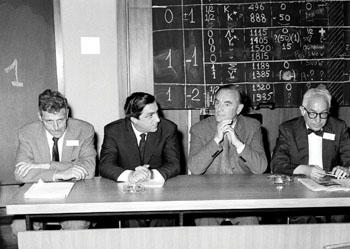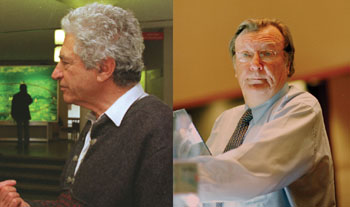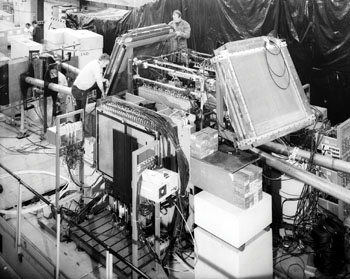After help from an eminent US figure, CERN was founded in the 1950s to provide a European stage for physics. Once the curtain was up, US physicists found the new laboratory increasingly attractive. In the first of two articles, Gordon Fraser traces the history of CERN-US collaboration from the post-war era to the advent of collider physics in the 1970s.

In the late 1940s, Europe was struggling to emerge from the ruins of the Second World War. The US had played a vital role in the conflict, but had been less affected materially, and a shining vision of life across the Atlantic was a beacon of hope for millions of Europeans living in austerity, if not misery.
In a speech at Harvard on 5 June 1947, US Secretary of State George C Marshall said that the US should help to “assist in the return of normal economic health in the world”. North American “Marshall aid” was a major factor in restoring European economic health and dignity.
During the global conflict, many eminent European scientists had been drawn into the Manhattan Project at Los Alamos. Post-war, US science remained pre-eminent. Anxious to stem a “brain drain” of talent, farsighted pioneers saw that Europe needed a comparable scientific focus. This was the seed of an idea for a European centre for atomic research.
UNESCO role
One of the organizations established in the wake of the Second World War to help promote world peace and co-operation was the United Nations Educational, Scientific and Cultural Organization (UNESCO). At the UNESCO General Conference in Florence, Italy, in June 1950, the idea for a European scientific laboratory still lay dormant. Among the US delegation at Florence was Isidor Rabi, who had won a 1944 Nobel prize for his work on the magnetic properties of nuclei. Rabi had played a key wartime role at the MIT Radiation Laboratory, and understood how pressing scientific needs could be transformed into major new projects. After the war Rabi played a major role in establishing the US Brookhaven National Laboratory.
The establishment of an analogous European laboratory was to Rabi a natural and vital need. However, on arrival in Florence he was disturbed to find that there was no mention of this idea on the agenda. Two Europeans, Pierre Auger (then UNESCO’s director of exact and natural sciences) and Edoardo Amaldi, who was to be a constant driving force, helped Rabi through the intricacies of European committee formalities. So the European seed was fertilized and within a few years CERN was born.
Another major, and very different, US contribution to CERN came two years after the Florence meeting. In 1952 a group of European accelerator specialists – Odd Dahl of Norway, Frank Goward of the UK and Rolf Wideröe of Germany – visited Brookhaven. CERN’s initial goal was to build a scaled-up version of Brookhaven’s new synchrotron – the Cosmotron – and the CERN group were anxious to admire the highest-energy accelerator in the world at that time.
To prepare a welcome for the European visitors, Stanley Livingston at Brookhaven called together his accelerator specialists to see how they could help the Europeans. During one of these meetings Livingston pointed out that all of the machine’s C-shaped focusing magnets faced outwards. Why not make some of them face inwards? Quickly Ernest Courant and the rest of the Brookhaven team saw that arranging the magnets to face alternately inward and outward could increase the focusing power of the synchrotron. The European visitors arrived just as the implications of the “alternating gradient” idea were being appreciated.
The CERN team took the idea back to Europe and immediately incorporated it into their new synchrotron design. Two members of the Brookhaven team – John and Hildred Blewett – later went to CERN and played a major role in ensuring that the new CERN Proton Synchrotron (PS) delivered its first high-energy protons in November 1959, several months before Brookhaven’s Alternating Gradient Synchrotron. This was the start of a long tradition of US-Europe collaboration in development work for major particle beam machines, which continues to this day.
Ernest Courant later made important contributions to CERN’s Intersecting Storage Rings (ISR) project, helping to convince accelerator physicists that beams in a proton collider could remain stable for long periods. In the early 1970s, CERN specialists came to Fermilab to help build and commission the big new US synchrotron. A few years later, US machine physicists came to CERN when the comparable Super Proton Synchrotron was getting under way. In the mid-1970s, Burt Richter of SLAC, during a sabbatical sojourn at CERN, helped set the scale for CERN’s LEP electron-positron collider, which had to be built as large as possible to minimize the losses caused by synchrotron radiation. The design eventually settled on a circumference of 27 km.
CERN officially came into being in 1954 when its convention document was ratified by the founding member states. Three years later, its first particle accelerator, a 600 MeV synchrocyclotron (SC), began operations. SC experiments on pion decay soon began to make their mark on the world particle physics scene. Slower to get going at the SC was a major effort to precision measure the magnetic moment of the muon – the famous g-2 experiment.
CERN experiments and major international physics conferences at CERN and in Geneva in the late 1950s introduced many US experimentalists to the attractions of Europe for a short visit or a longer sabbatical stay. One of these was Leon Lederman, newly tenured at Columbia, who made many useful contacts during his first stay at CERN and who left resolved to return. The SC g-2 experiment involved a lot of physicists by the standards of the day and attracted several other major US figures. Some also collaborated in bubble-chamber studies at CERN to determine particle properties vital for the emerging particle classification schemes based on internal symmetry.
As one of CERN’s main aims was to stem the tide of scientific migration westwards across the Atlantic, it was natural for the laboratory to headhunt Europeans who had made the move to the US. So CERN’s first director-general was the Swiss physicist Felix Bloch, who had left Europe in 1933 and went on to win a 1952 Nobel prize for measurements of nuclear magnetism. However, Bloch’s move to CERN was not a success.
Another contemporary colossus straddling the Atlantic was Victor Weisskopf. Austrian by birth, Weisskopf had made pioneering contributions to quantum mechanics in Europe in the 1930s, and, like Bloch and many others, had fled to the US to escape Nazi persecution, eventually making his way to Rochester. During the Second World War Weisskopf had worked at Los Alamos as deputy to theory division leader Hans Bethe. At Los Alamos, Weisskopf developed a flair for 20th-century “big science”.
When CERN was looking for a new director-general in the early 1960s, Weisskopf was a natural candidate, a distinguished European with experience in the management of big physics projects. Despite his protests that he knew little about administration, he was pushed into the job and CERN flourished. During Weisskopf’s mandate CERN developed a strong sense of purpose, and ambitious new projects for the future were authorized.

Younger Europeans who had been working in the US also chose CERN as their research base for a return to Europe in the early 1960s. Several were to go on to become very influential. Jack Steinberger emigrated to the US in 1934 and went on to make landmark contributions, mainly with bubble chambers, at the new generation of post-war accelerators at Berkeley, Columbia and Brookhaven. At CERN, Steinberger switched to electronic detectors.
After completing his degree at Pisa, Carlo Rubbia moved to Columbia for a taste of front-line research in weak interaction physics before moving to the SC at CERN. In their subsequent careers, Rubbia and Steinberger were highly visible from either side of the Atlantic. Both these physicists participated in the first studies at CERN of the phenomenon of CP violation, discovered at Brookhaven in 1964.
The Ford Foundation provided generous funding so that scientists from nations that were not signatories to the CERN Convention could participate in the laboratory’s research programme. In this way, more young US researchers were able to visit. One was Sam Ting, who worked at the PS as a Ford Foundation fellow with Giuseppe Cocconi.
ISR testbed

Under Weisskopf, CERN’s next major project was the innovative ISR, the world’s first proton-proton colliding beam machine, which came into operation in 1971. It was unique. For the first time, Europe had a kind of front-line particle physics machine that the US didn’t, attaining a totally new energy range, and many scientists were keen to see what it could do. Among the first to make the eastward pilgrimage to Geneva were Leon Lederman of Columbia and Rod Cool of Rockefeller.
Working at Brookhaven, Lederman had studied the production of muon pairs, initially hunting for the intermediate boson, the carrier of the weak nuclear interaction. This hunt was some 15 years premature, but on the other hand it convinced Lederman, and others, of the value of lepton pairs as a signature of basic interactions.

At the ISR, a Europe-Columbia-Rockefeller collaboration was among the first to see that under ISR conditions some high-energy particles emerged at wide angles to the direction of the colliding beams. This suggested that occasionally something violent happened when the proton beams clashed together. It was a few years after the historic experiments at SLAC, which had used electrons to probe deep inside the proton and see that it contained hard scattering centres, but the ISR experiments saw the constituents deep inside protons colliding with each other.
Over the lifetime of the ISR (1971-84), US participation in experiments at CERN developed from small bands of intrepid pioneers to major groups. Other active collaborations involved researchers from Brookhaven, Harvard, MIT, Northwestern, Riverside, Stony Brook, Syracuse and UCLA.
A major US contribution at CERN was the 1979 discovery at the ISR of direct single photons from quark processes – the first sighting of electromagnetic radiation from quarks. Playing an important role here was Bob Palmer, a European migrant to the US who retained an attachment to CERN.
Over its first decade of operation the ISR made it clear that “keyhole physics”, using just a small sample of the produced particles, was not the only way to go, and colliding beam machines needed big detectors to intercept as many as possible of the emerging particles. With their ISR apprenticeship, US physicists learned this lesson early.
The second half of this history will look at US involvement in modern collider physics at CERN.







